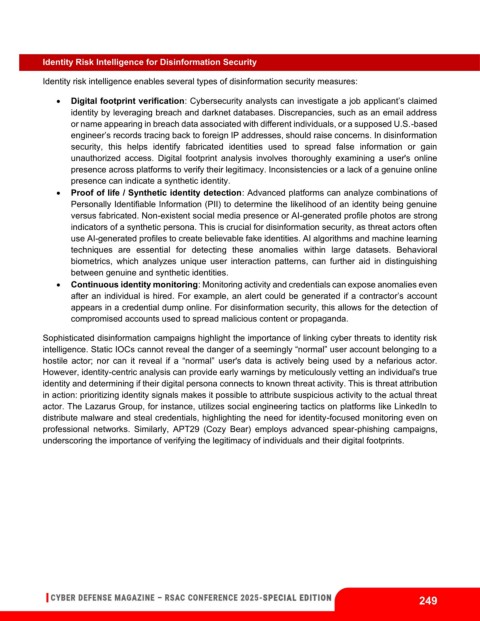Page 249 - Cyber Defense eMagazine RSAC Special Edition 2025
P. 249
Identity Risk Intelligence for Disinformation Security
Identity risk intelligence enables several types of disinformation security measures:
• Digital footprint verification: Cybersecurity analysts can investigate a job applicant’s claimed
identity by leveraging breach and darknet databases. Discrepancies, such as an email address
or name appearing in breach data associated with different individuals, or a supposed U.S.-based
engineer’s records tracing back to foreign IP addresses, should raise concerns. In disinformation
security, this helps identify fabricated identities used to spread false information or gain
unauthorized access. Digital footprint analysis involves thoroughly examining a user's online
presence across platforms to verify their legitimacy. Inconsistencies or a lack of a genuine online
presence can indicate a synthetic identity.
• Proof of life / Synthetic identity detection: Advanced platforms can analyze combinations of
Personally Identifiable Information (PII) to determine the likelihood of an identity being genuine
versus fabricated. Non-existent social media presence or AI-generated profile photos are strong
indicators of a synthetic persona. This is crucial for disinformation security, as threat actors often
use AI-generated profiles to create believable fake identities. AI algorithms and machine learning
techniques are essential for detecting these anomalies within large datasets. Behavioral
biometrics, which analyzes unique user interaction patterns, can further aid in distinguishing
between genuine and synthetic identities.
• Continuous identity monitoring: Monitoring activity and credentials can expose anomalies even
after an individual is hired. For example, an alert could be generated if a contractor’s account
appears in a credential dump online. For disinformation security, this allows for the detection of
compromised accounts used to spread malicious content or propaganda.
Sophisticated disinformation campaigns highlight the importance of linking cyber threats to identity risk
intelligence. Static IOCs cannot reveal the danger of a seemingly “normal” user account belonging to a
hostile actor; nor can it reveal if a “normal” user's data is actively being used by a nefarious actor.
However, identity-centric analysis can provide early warnings by meticulously vetting an individual's true
identity and determining if their digital persona connects to known threat activity. This is threat attribution
in action: prioritizing identity signals makes it possible to attribute suspicious activity to the actual threat
actor. The Lazarus Group, for instance, utilizes social engineering tactics on platforms like LinkedIn to
distribute malware and steal credentials, highlighting the need for identity-focused monitoring even on
professional networks. Similarly, APT29 (Cozy Bear) employs advanced spear-phishing campaigns,
underscoring the importance of verifying the legitimacy of individuals and their digital footprints.
249

